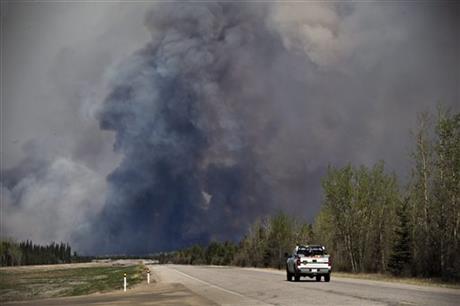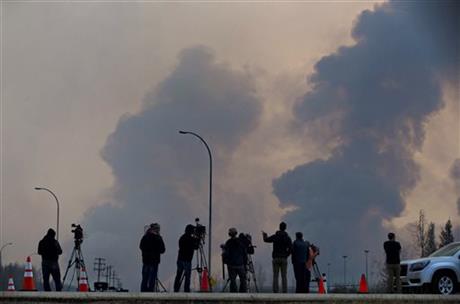- California Assembly OKs highest minimum wage in nation
- S. Korea unveils first graphic cigarette warnings
- US joins with South Korea, Japan in bid to deter North Korea
- LPGA golfer Chun In-gee finally back in action
- S. Korea won’t be top seed in final World Cup qualification round
- US men’s soccer misses 2nd straight Olympics
- US back on track in qualifying with 4-0 win over Guatemala
- High-intensity workout injuries spawn cottage industry
- CDC expands range of Zika mosquitoes into parts of Northeast
- Who knew? ‘The Walking Dead’ is helping families connect
Canadian convoy begins, hoping to flee wildfire zone
FORT MCMURRAY, Alberta (AP) — A massive convoy was under way Friday to move evacuees stranded at oil field camps north of wildfire-ravaged Fort McMurray, Alberta, through the community to safe areas south of the Canadian oil sands capital.
As police and military oversaw the procession of at least 500 vehicles, a mass airlift of evacuees resumed. A day after 8,000 people were flown out, 5,500 more were expected to be flown out on Friday.
More than 80,000 people have left Fort McMurray in the heart of Canada’ oil sands, where the fire has torched 1,600 homes and other buildings. The mass evacuation has forced as much as a quarter of Canada’s oil output off-line according to estimates and is expected to impact a country already hurt by a dramatic fall in the price of oil.
The Alberta provincial government, which declared a state of emergency, said Friday the size of the fire had grown to more than 101,000 hectares (249,571 acres). No deaths or injuries related to the fire have been reported.
The government said 1,100 firefighters, 110 helicopters, 295 pieces of heavy equipment and more than 27 air tankers were fighting the fire, but Chad Morrison, Alberta’s manager of wildfire prevention, said no amount of resources would put this fire out. They need rain.
“We have not seen rain in this area for the last two months of significance,” Morrison said. “This fire will continue to burn for a very long time until we see some significant rain.”
Environment Canada forecast a 40 percent chance of showers in the area on Sunday.
About 25,000 evacuees moved north in the hours after Tuesday’s mandatory evacuation, where oil sands work camps that usually house employees were used to house evacuees. But the bulk of the more than 80,000 evacuees fled south to Edmonton and elsewhere, and officials are moving everyone south where it is safer and they can get better support services.
The Alberta government is providing cash to 80,000 evacuees from the Fort McMurray fire to help them with their immediate needs. Premier Rachel Notley said her cabinet has approved a payment of $1,250 Canadian (US$967) per adult and $500 Canadian (US$387) per dependent at a cost to the province of $100 million Canadian (US$77 million). She told a briefing in Edmonton that she wants people who were forced from their homes to know that the government “has their back.”
Police are escorting 50 vehicles at a time, south through the city itself on Highway 63 at a distance of about 20 kilometers (12.4 miles) south and then releasing the convoy. At that point another convoy of 50 cars will begin.
All intersections along the convoy route have been blocked off and evacuees are not being allowed back to check on their homes in Fort McMurray.
Sgt. John Spaans, a Royal Canadian Mounted Police spokesman, said the goal was to get all vehicles out of the area Friday if the weather, fire and road conditions cooperate, but officials later said in a release it would take about four days.
Fort McMurray is surrounded by wilderness, and there are essentially only two ways out via road.
Crystal Mercredi packed her two kids and got out of town Tuesday, and even though her husband was just 20 minutes behind packing a trailer, he didn’t get out until hours later because it was bumper to bumper traffic as the fire descended upon the city.
“I was worried that we were going to lose him,” she said in a telephone interview. “He knew that I was upset so he jumped the curb on the wrong side of the road and got out.”
Mercredi evacuated north but then moved south overnight and headed to Lac La Biche, Alberta, about 175 kilometers (109 miles) south, where her family has a lake house that housed 50 people the first night of the mandatory evacuation.
Lac La Biche, normally a sleepy town of 2,500, is helping about 12,000 evacuees, providing a place to sleep, food, donated clothes and even shelter for their pets.
Mercredi said she was lucky that a Shell employee filled their tank with gas after they initially evacuated north. That allowed them to escape south to Lac La Biche. She believes her Fort McMurray home is still intact but said her best friend lost hers based on video they saw. She said she and her family have had trouble sleeping and have had nightmares involving fires.
Fanned by high winds, scorching heat and low humidity, the fire grew from 75 square kilometers (29 square miles) Tuesday to 100 square kilometers (39 square miles) on Wednesday, but by Thursday it was almost nine times that — at 850 square kilometers (330 square miles). That’s an area roughly the size of Calgary, Alberta’s largest city. The fire is so large that smoke from the fair is blanketing parts of the neighboring province of Saskatchewan where Environment Canada has issued special air quality statements for several areas.
Unseasonably hot temperatures combined with dry conditions have transformed the boreal forest in much of Alberta into a tinder box. Morrison, the wildfire prevention manager, said the cause of the fire hasn’t been determined, but he said it started in a remote forested area and could have been ignited by lightning.
“They are dealing with a beast of a fire, one of the worst we’ve ever seen,” Federal Public Safety Minister Ralph Goodale said.
Goodale said firefighters and water bombers from other Canadian provinces are arriving and if more is required they’ll ask the United States.
The federal government is providing air assets and 7,000 cots for evacuees in emergency shelters, with 13,000 more on the way.
The region has the third-largest reserves of oil in the world behind Saudi Arabia and Venezuela.
Greg Pardy, an analyst with RBC Capital Markets, said that as much as 1 million barrels a day of oil may be offline, based on oil company announcements. That’s just over a third of Canada’s total oilsands output, Pardy noted.














after the civil
May 7, 2016 at 2:33 AM
Connect with EarthLink, the award-winning Internet service …
kelly
November 23, 2017 at 11:56 AM
Very nice and always successful.
This is a very good article.
I’m waiting for you the other article.
togelpelangi